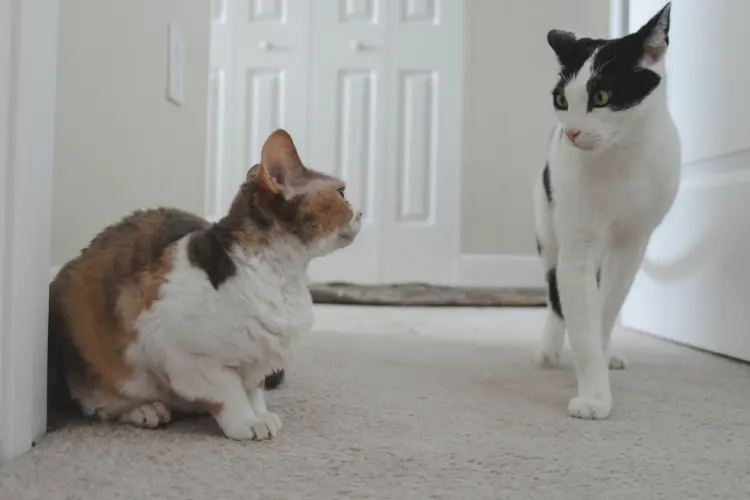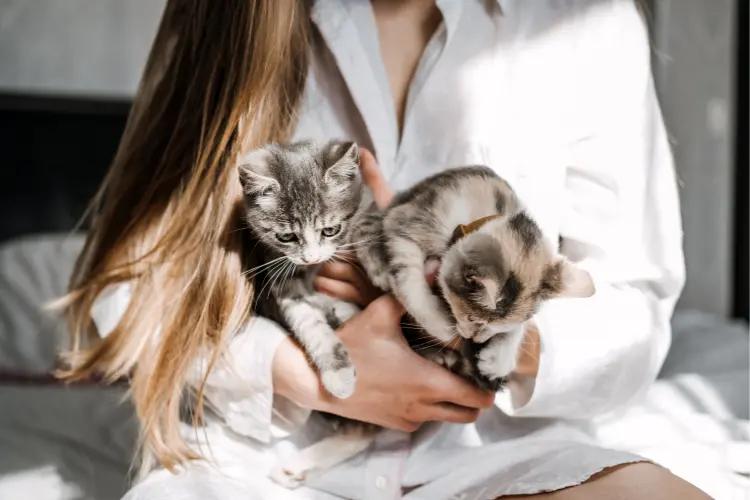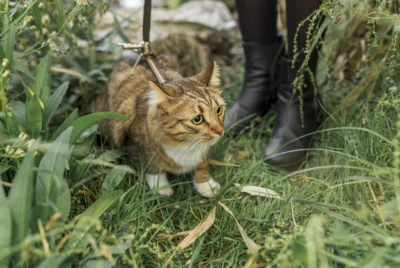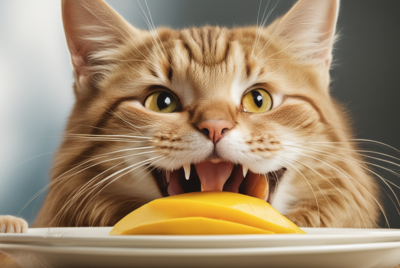Top 10 Warning Signs When Introducing Cats
Introducing a new cat to your feline family can be a delicate process. Recognizing warning signs when introducing cats ensures a smooth and successful integration. In this blog post, I delve into the various warning signs to look out for during cat introductions, as well as effective strategies to help both your resident kitty and new addition feel comfortable and safe.
By understanding the nuances of feline behavior, you’ll be well on your way to creating a harmonious and happy household for all your furry friends.
Warning Sign #1: Attempts To Swat/Slap/Bite

When introducing cats, attempts to swat, slap, or bite the feline companion are clear indicators of aggression. Such behavior should be halted promptly, as it can lead to physical and psychological damage for both cats.
Allowing cats to engage in combat during introductions could result in considerable psychological trauma, making it more difficult to establish a harmonious relationship between the feline companions.
Being cognizant of these warning signs during cat introductions and intervening when required is paramount. Early intervention in aggressive cat behavior, can contribute to a smoother introduction process and hinder the development of any long-term negative associations between the cats.
Warning Sign #2: Loud Vocalizations

Cats may exhibit vocalizations during introductions, such as howling, yowling, or snarling. These sounds can indicate distress and potential aggression, necessitating intervention and separation.
Cats exhibit a range of behaviors when feeling threatened or scared. Yowling, wailing and screaming are among those behaviors. In such cases, the situation could rapidly progress into a catfight.
Being attentive to these loud vocalizations during cat introductions can help minimize the risk of aggression and ensure a more successful integration.
Warning Sign #3: Hiding
Hiding during introductions indicates extreme fear or stress, necessitating a pause in the interaction to allow the cat to recover. Exceedingly frightened cats may attempt to flee and find a place to hide.
Extreme anxiety can be alleviated by halting the interaction and giving the cats time to relax. By providing each cat with a separate space to retreat to, you can help them feel secure and reduce their anxiety levels.
It’s crucial to monitor the cats during the introduction process and intervene when necessary. By addressing the hiding behavior early on, you can prevent the development of long-lasting fear and stress, ultimately increasing the chances of a successful cat introduction.
Warning Sign #4: Puffed Out Hair

Puffed-out hair, also known as piloerection, occurs when a cat’s hair stands out along its body and tail, making them appear larger and more intimidating. This behavior reflects stress and fear, which if not appropriately managed, can potentially escalate into aggression. A puffed-up tail, for example, indicates that a cat is feeling threatened or defensive.
Closely observing the cats during introductions is vital, and the interaction should be immediately halted if their hair becomes puffed out. By addressing this behavior early, you can prevent the situation from escalating and ensure a smoother and safer introduction process for both cats.
Warning Sign #5: Flattened Ears

Flattened ears are indicative of fear or aggression in cats and indicate the necessity to cease the interaction. This particular body language serves as a warning sign that the cat is feeling threatened, and continuing the interaction could result in potential harm.
Quick identification of fear or aggression signs during introductions can be facilitated by monitoring flattened ears.
Warning Sign #6: Growling

Growling is a low rumbling sound. It serves as a warning sign for a threatened cat when two cats meet for the first time. If one of the cats growls, they must be immediately separated. This sound indicates that the cat feels threatened and desires to be left alone, so continuing the interaction may lead to aggression and potential harm.
Monitoring the cats for growling during introductions enables quick identification of potential issues and separation of the cats when needed. This proactive approach helps to ensure a more successful cat introduction process.
Warning Sign #7: Hissing

Hissing is a negative vocalization that can occur during cat introductions, indicating fear, stress, or aggression. If a cat hisses during an introduction, it can be interpreted as a sign that the current cat feels scared and threatened. In these situations, I advise intervening and separating the cats to reduce tension and prevent potential altercations.
By being aware of hissing during cat introductions, you can ensure the safety and well-being of both cats.
Warning Sign #8: Staring

Staring between cats during introductions can potentially lead to aggression and should be avoided. When two cats maintain eye contact without interruption, it’s indicative of a negative interaction that needs to be promptly terminated. If the cats are observed staring at each other for an extended period, I recommend separating them to reduce tension and avert potential altercations.
Being proactive in addressing staring behavior can help to minimize the risk of aggression and foster a peaceful coexistence for your feline friends.
Warning Sign #9: Tail Swishing

Tail swishing is a warning sign that most cats use to indicate their mood. Rapid tail swishing from side to side signifies annoyance or the need for personal space.
On the other hand, sluggish tail swishing may suggest curiosity or engagement. Cat owners should be aware that if rapid tail swishing occurs during introductions, you should discontinue the interaction as the cat evidently desires some space.
Understanding and respecting each cat’s need for personal space is crucial for fostering harmonious relationships between your feline companions.
Warning Sign #10: Dilated Pupils
Cats with dilated pupils can be an indication of their emotional state. This state can range from excitement to fear or over-stimulation. During introductions, I suggest monitoring the cats’ pupils for dilation and assess their overall behavior to determine the underlying cause. This can help you identify potential issues and intervene if necessary to prevent aggressive behavior and ensure a successful cat introduction.
Strategies for a Successful Cat Introduction
In addition to recognizing warning signs, there are several strategies that you can implement to ensure a successful cat introduction.
Creating a Safe Space
Providing a separate, safe space for each cat in their cat home with essentials such as:
a litter box
food and water bowls
a cardboard box for hiding
a cozy cat bed
a scratching post
some fun toys
These can help them adjust before meeting. This safe space allows the new cat to acclimate to their new environment and reduces stress levels before introducing them to the resident adult cat.
In addition to the physical resources, you can also use a diffuser in the new cat’s room, the living room, and walkways to help them become more at ease. The diffuser releases pheromones that assist cats in calming down during stressful situations, further promoting a successful introduction.
Gradual Exposure
Gradual exposure is a key strategy in successful cat introductions. Scent swapping, for example, involves exchanging the cats’ bedding and litter boxes to accustom them to one another’s scent, which can be a beneficial aid in cat introductions.
Visual contact can also be established by allowing the cats to observe each other through a glass door, tall baby gate, or door crack without causing any harm.

Supervised interactions can then be conducted, monitoring the cats for any aggressive behavior or warning signs and intervening if necessary. By gradually exposing the cats to each other’s scent and presence, you can help them become familiar with each other. This measured approach increases the chances of a successful and harmonious integration.
Positive Reinforcement
Positive reinforcement is a training technique that rewards desired behavior with treats, play, or petting, thus encouraging the cat to repeat the behavior in the future.
During cat introductions, using positive reinforcement to reward calm behavior and positive interactions can help establish a strong bond between the cats and foster a peaceful coexistence.
By using reward positive behavior when the cats interact positively, you encourage them to repeat the behavior in the future. This approach encourages a strong bond between the cats and creates a harmonious environment in your home.
Handling Challenges During Cat Introductions
Dealing with Aggression
Aggressive behavior during cat introductions can be a major challenge for new pet owners. If aggression is observed, it’s important to separate the cats immediately and attempt reintroduction when both cats have had a chance to relax.
By addressing aggression promptly, you can minimize the risk of harm to both cats and ensure a smoother integration process.
In some cases, seeking professional help may be necessary if the cats continue to exhibit aggressive behavior or if the introduction process is not progressing as anticipated. A professional can provide guidance and recommend specific techniques to help manage aggression and ensure a successful cat introduction.
Helping Shy or Fearful Cats
Shy or fearful cats may require additional support during introductions. Providing hiding spots and reassurance can help these cats feel more secure and comfortable during the process.
Creating a secure and tranquil environment for the shy or fearful cat to retreat to is essential, which may be accomplished through the use of a cardboard box, a pet carrier, or a cat tree with a covered area.
Along with providing hiding spots, reassuring shy or fearful cats during introductions is necessary. This can be achieved by using a calm and soothing vocal tone, rewarding desirable behavior with treats or toys, and gently petting the cat non-threateningly.
Monitoring Health and Well-being
Monitoring the health and well-being of both cats during the introduction process is vital. Be alert for any signs of stress, such as changes in appetite, behavior, or elimination habits. By closely observing the cats and addressing any potential issues early on, you can ensure their overall health and well-being during this critical period. Monitoring health and well-being also includes looking out for any warning signs mentioned.
Effective management of the introduction process and the creation of a harmonious environment for your new feline companion or companions can be achieved by addressing these warning signs and intervening when necessary.
How To Prevent Future Conflicts
Maintaining Separate Resources
Cats are known to be territorial creatures, so providing multiple resources such as litter boxes, feeding stations, and sleeping areas in separate room can help to diminish competition between resident cats and other cats.
Risk of territorial disputes can be minimized and peaceful coexistence is promoted by ensuring each cat has access to their resources.
It’s important to place these resources in different areas of the house, so each cat has access to them. By doing so, you can help prevent resource monopolization and ensure that all cats have the necessary resources to thrive in your household.
Encouraging Positive Interactions
Encouraging positive interactions between your cats is crucial for fostering a harmonious environment. Engaging in play, shared activities, and providing treats can help initiate positive interactions between the cats. By offering cats a chance to interact in an enjoyable and secure atmosphere, you can help strengthen the bond between them.

Monitoring the cats’ interactions and rewarding them with treats and praise when they interact positively can also encourage a strong bond between all the cats and create a peaceful coexistence. By fostering positive interactions between your cats, you can promote a harmonious and happy household for all your furry friends.
Read also: Symptoms of Dead Kitten Inside Cat
Monitoring Behavior Changes
Observing your cats for any changes in behavior, health, or well-being is essential for preventing future conflicts and ensuring their overall happiness. Be attentive to any signs of:
aggression
increased vocalization
hiding
other behavioral changes
These may indicate an issue. Prompt attention to any changes in behavior, health, or well-being can minimize the risk of future conflicts and sustain a peaceful environment for your feline companions.
Regular monitoring and intervention when necessary can help ensure a harmonious coexistence for your cats and create a happy, stress-free home for all members of your feline family.
Summary
Recognizing warning signs when introducing cats, employing effective strategies for successful introductions, and handling challenges during the process are essential to creating a harmonious and happy household for your feline companions.
By understanding the nuances of feline behavior, addressing any potential issues promptly, and fostering positive interactions between your cats, you can ensure a peaceful coexistence for your furry friends and create a loving, stress-free home for all.



